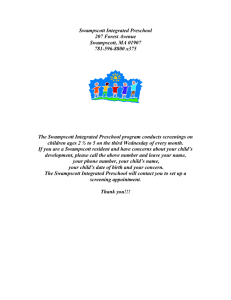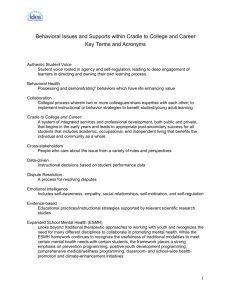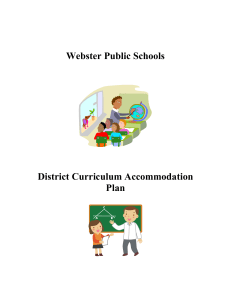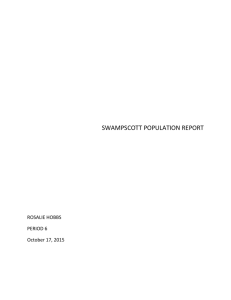Swampscott.DCAP - Swampscott School District
advertisement
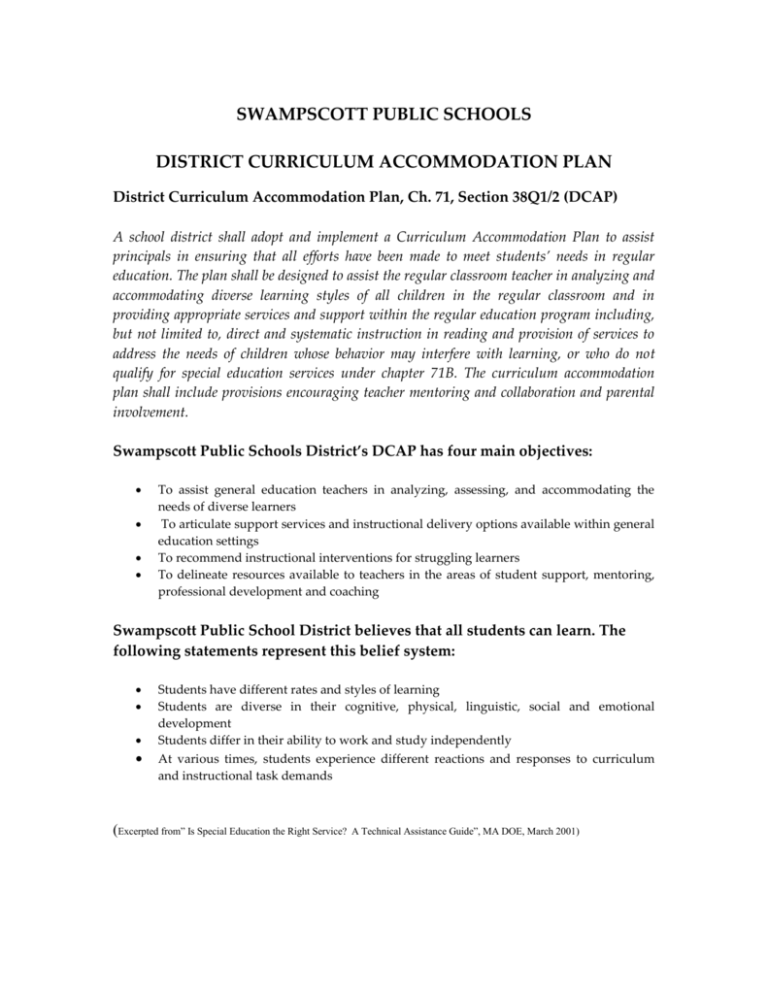
SWAMPSCOTT PUBLIC SCHOOLS DISTRICT CURRICULUM ACCOMMODATION PLAN District Curriculum Accommodation Plan, Ch. 71, Section 38Q1/2 (DCAP) A school district shall adopt and implement a Curriculum Accommodation Plan to assist principals in ensuring that all efforts have been made to meet students’ needs in regular education. The plan shall be designed to assist the regular classroom teacher in analyzing and accommodating diverse learning styles of all children in the regular classroom and in providing appropriate services and support within the regular education program including, but not limited to, direct and systematic instruction in reading and provision of services to address the needs of children whose behavior may interfere with learning, or who do not qualify for special education services under chapter 71B. The curriculum accommodation plan shall include provisions encouraging teacher mentoring and collaboration and parental involvement. Swampscott Public Schools District’s DCAP has four main objectives: To assist general education teachers in analyzing, assessing, and accommodating the needs of diverse learners To articulate support services and instructional delivery options available within general education settings To recommend instructional interventions for struggling learners To delineate resources available to teachers in the areas of student support, mentoring, professional development and coaching Swampscott Public School District believes that all students can learn. The following statements represent this belief system: Students have different rates and styles of learning Students are diverse in their cognitive, physical, linguistic, social and emotional development Students differ in their ability to work and study independently At various times, students experience different reactions and responses to curriculum and instructional task demands (Excerpted from” Is Special Education the Right Service? A Technical Assistance Guide”, MA DOE, March 2001) Student and Program Supports Pre k -12 Modifying Curriculum Modalities Flexible grouping Technology/Assistive technology Instructional Support Teams Bullying Prevention Programs Tiered Instruction Early intervening services Access to consulting Clinical Psychologist Access to BCBA ELL support services PreK Consultation to pre-school programs Screenings Social skills curriculum Classroom supports with Educational Support Personnel (ESP) Classroom supports with Applied Behavioral Analysis Tutors (ABA) BCBA/Director of Programming Kindergarten through 4th grade Reading Interventionist DIBELS Math Interventionists Average class size 22:1 School Adjustment Counselor or School Psychologist MCAS Prep (Grades 3-4) Social skills instructions Educational Support Personnel (K only) Child Assistance Team (CHAT) Balance literacy program (K-5) Middle School (5 through 8) MCAS Prep Summer school Counseling services (individual/group) Reading enrichment Math enrichment Social skills groups STEM programming Student Assistance Team Daily email communication to parents High School In school MCAS remediation Peer tutoring Peer mentor Student Assistance Team (SAT) Educational Proficiency Plan (EPP) Foundation Classes Leveled classes Academic strategies course Co-teaching model Reduced scheduling/level change Counseling services DBT course STEM programming Global competency certificate Professional Development Resources for Pre-K – 12 Induction/mentoring program for new teachers Curriculum coordinators Curriculum task committees Summer curriculum work Contractual course work reimbursement Technology Training Professional Development Committees Access to consultation services Scheduled professional development days Encouragement of Parental Involvement School Advisory Councils K-4 - PTO/PTA, 5-8 - PTO, 9-12 – PTF System Wide Special Education Parent Advisory Council (SEPAC) Membership on screening committees Parent information nights (orientations) School transition meetings Newsletters/school and classroom Website information Accommodations Physical/Structural Preferred seating Reduce/minimize distractions Movement and sensory breaks Access to seat cushions/stress balls as needed Visual, auditory and transitional aides Alternative workspace Flexible student grouping Organization Contracts for learning Flexible schedule Clear routines Provide organizational strategies Time management tools such as daily planners After-school supports Behavioral/Social Emotional Post and teach behavioral expectations across settings Use of positive reinforcement, rewards and incentives Access to school counseling services Use diverse classroom management techniques Set clearly defined standards of behavior Develop strategies for behavior modification Use of charts and graphs to monitor student progress Develop student contracts or behavioral improvement plans Provide self monitoring checklists and strategies Instructional/Assessments Provide assistance with note taking Provide manipulatives Differentiate instruction Provide visual cues Break down tasks into manageable parts Provide graphic organizers and/or outlines Incorporate study skill strategies into lessons Provide reference tools Reduce workload when deemed appropriate Create contracts with students Clarify directions Models of end products Use of assistive technology Offer calculators when appropriate Model test taking strategies Provide alternate forms of assessments Use of alternate setting for assessments

